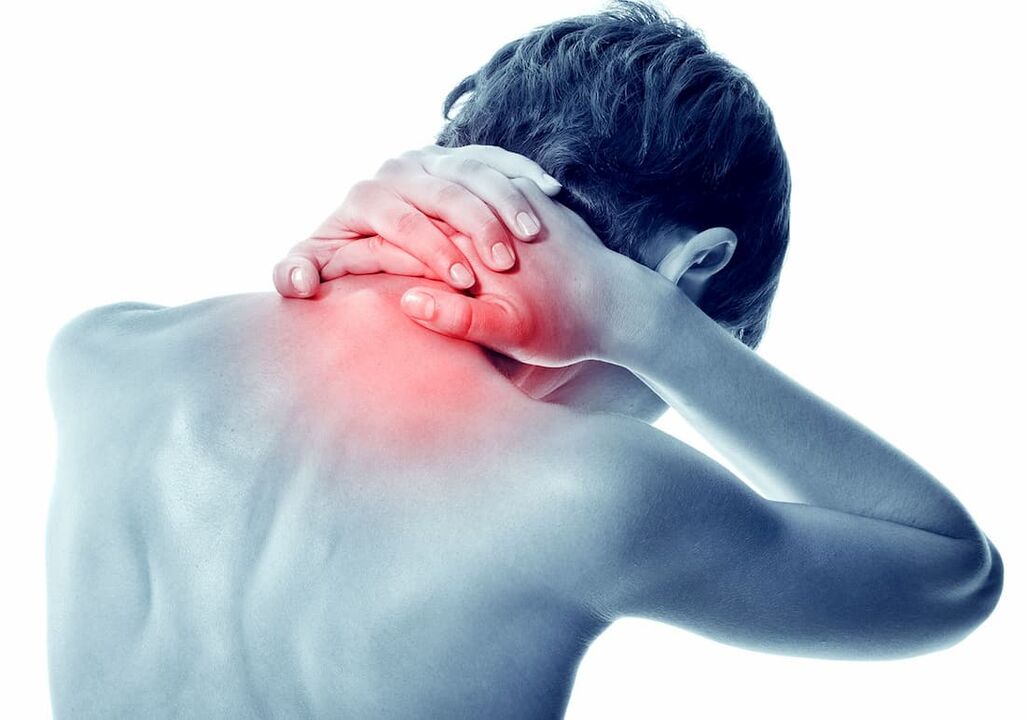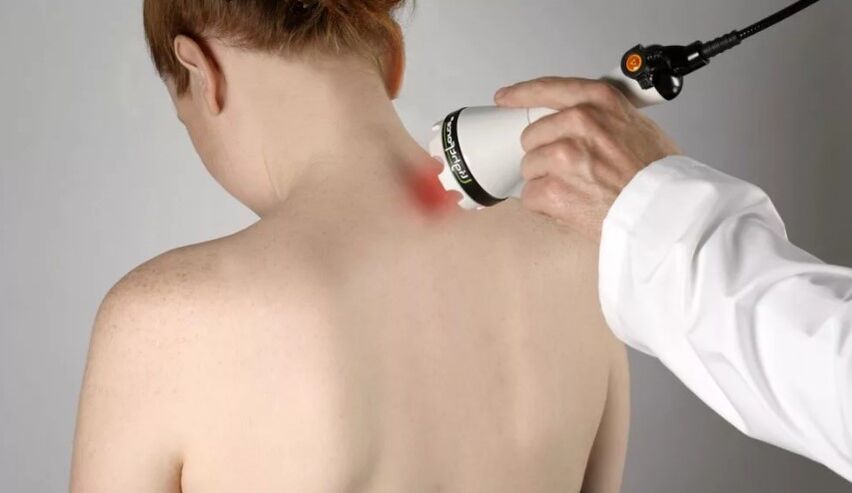
Cervical osteochondrosis is a chronic dystrophic disease in which the panes between the vertebrae are thinner, followed by their bone tissue.The surrounding structures are involved in the course of the degenerative process.This is the reason for the development of a whole complex of symptoms that fully subject the patient's life.
General information
Intervertebral discs consist of a core cut with gel and a dense fiber ring that is covered with a layer of cartilage.They carry out a shock absorbing function that prevent vertebral damage while running, walking and jumping and also contribute to the mobility and flexibility of the entire spine.
With natural aging and increased stress conditions, the height of the intervertebral disc occurs gradually.The metabolism is disturbed, cracks occur in the surrounding fiber ring.Putches of Discs - lead and hernia appear.In the course of the disease, cartilage tissues and bones are involved, osteophytes occur - bone growth, which cause a limitation of mobility and a pronounced pain syndrome.
Since pathological changes take place in the immediate vicinity of the spinal cord and its roots, this leads to its compression and inflammation as well as the reflex development of muscle pasmeness.As a result, a person experiences characteristic symptoms through which the disease can be suspected.
Reasons
Osteochondrosis of the cervical spine refers to multifactorial diseases.Against the background of a whole complex of factors, it arises, each of which worsens the flow of pathology.The list of reasons includes:
- excess body weight;
- sitting lifestyle;
- Sitting work;
- improper attitude;
- Chronic diseases of the musculoskeletal system (scoliosis, flat feet), which contribute to the uneven distribution of the load on the spine;
- Congenital pathologies of the development of the spine and injuries;
- excessive, repeated loads on the spine;
- Hereditary disposition.
Symptoms and syndromes
The symptoms of cervical osteochondrosis do not occur immediately and are often disguised as other diseases.
The most common signs are:
- Dizziness: Usually it is systemic with osteochondrosis, i.e.H. It seems a person that the surrounding objects revolve before his eyes;
- The pain in the neck, neck and collar zone: its intensity depends on the degree of development of the disease;Light and episodic in an early stage spreads over the entire head and acquires a constant character.Periodically attacks become unbearable, although a person cannot even move their heads;
- Noise or ringing in the ears: arise when a position changes after a long period of immobility that is often accompanied by dizziness;
- A feeling of lack of air, the inability to take a deep breath;In severe cases, severe breath strength arises;
- Nausea and vomiting: If circulatory disorders are connected in certain brain zones, when you try to turn your head.
- Reducing views, flickering flies or fog in front of the eyes: indicate insufficient care for the blood of the brain;with advanced stages of the disease;
- Blood pressure fluctuations, bad too correctable for correction with medicinal products;
- Sudden fainting caused by the phenary of blood vessels;
- The feeling of a lump in the throat, pain, drought, problems when swallowing is often one of the first signs of pathology;
- Pain in the shoulder joint;
- Deafness of the fingers.
In addition to the general signs of cervical osteochondrosis, several syndromes characteristic of this disease are differentiated.
Wirbel syndrome
The complex of symptoms is associated with damage to bones and cartilage of the spine.It includes:
- Violation of mobility in the cervix region;
- Pain when turning the head;
- X -rays Signs of damage to the vertebrae and the space between them.
Vail arteries syndrome
The symptoms are caused by narrowing or cramp of the vertebral arteries, some of which are responsible for the blood supply to the brain.It manifests itself through the following signs:
- Noise in the ears;
- Dizziness;
- Jumps in blood pressure;
- Nausea and vomiting;
- Headache;
- Visual impairment;
- Performance acceptance;
- Sleepiness;
- Fainting.
Cardial syndrome
Is similar to a disease with damage to the heart muscle and includes:
- Pain or burning feeling behind the sternum;
- Weakness and fatigue;
- Quick pulse.
Rook syndrome
The condition is associated with damage (compression or clamping) of the nerve roots, which emerges from the spine in the neck area.Depending on the defeat, a person can have the feeling:
- Daubiness or pain in the back of the head;
- Deafness of language;
- Pain in the collarbone, difficulties when swallowing, swallowing;
- Complaints in the shoulder area intensify with hand movements;
- Pain in the area of blades and forearms;
- Daubiness of the index and the middle finger;
- Daubiness of the ring finger and little finger.
Most of the time, several nerve roots are involved in the pathological process at the same time, which is why several characteristic symptoms are observed at the same time.
Level
In the development process, the cervical osteochondrosis pursues four consecutive stages (degree) that determine the severity of the symptoms and the general condition of the patient.
- 1. Level.The thickness of the intervertebral discs is slightly reduced.The symptoms are practically missing, sometimes there is slight discomfort in the neck, for example with a long stay in an unpleasant position.
- Level 2. The height of the disc becomes even smaller, the pathological growth of cartilage tissue begins, lead (lead) occurs.The pain becomes stronger, stiffness in the neck region joins it.
- Level 3. The fibrous ring that surrounds the core of the pane is torn, an intermediate umbrella is formed.The spine is noticeably deformed, the risk of transfers and subluxation of the vertebrae increases.The pain becomes constant in nature, other symptoms of osteochondrosis combine.
- 4. Level.Irrversible changes occur in the spine: bone growth occur, the intervertebral disc is replaced by a scar tissue and loses the ability to pay the load.The symptoms are pronounced and have a significant impact on the patient's lifestyle and his well.The quality of life is reduced.
Diagnosis
In search of the causes of pain or dizziness, the patient can contact doctors from different specialties: therapist, cardiologist, gastroenterologist, neurologist.A comprehensive examination is required to diagnose osteochondrosis, including:
- X -Ray and computer tomography are only effective in the late stages of the development of the disease if the changes become clearly visible.
- Magnetic resonance imaging: Due to a high degree of visualization, you can even recognize initial changes.It is currently the main method of diagnosis.
- Duplex scanning of the arteries of the head and neck: enables you to identify the quality of the blood flow and the narrowing of the vessels.Is used to determine the causes of headache and dizziness.
The obligatory examination and examination of the patient, the determination of the pain zones and the degree of mobility of the spine are assessed, the quality of the reflexes is carried out.For differential diagnosis with other diseases with similar symptoms, it can be prescribed:
- EKG, ultrasound of the heart;
- daily monitoring of EKG and blood pressure;
- X -Ray of the chest;
- Consultations by Engen Specialists: Cardiologist, Laura.
Treatment
The treatment of cervical osteochondrosis requires an integrated approach and includes:
- Medical effects;
- Physiotherapy;
- Physiotherapy sports lessons;
- Massage;
- Surgical treatment.
Drug treatment
The main objective of drug treatment: relieve pain and dizziness, restore the normal functionality of the nerve roots and stop or slow down the destruction of cartilage tissue if possible.Depending on the situation, they are prescribed:
- Not steroid anti -inflammatory drugs: pain and inflammation;They are used in the form of tablets, injections, ointments, plasters.
- Steroid medication: are also used to alleviate inflammation with the ineffectiveness of the NSAID.
- Musorelaxants: medication that eliminate reflex muscle cramps, with the pain removing and improving blood circulation;
- B -Vitamine in the form of injection or tablet medication: contribute to improving the nerve impulses;
- Seastant with severe pain syndrome to improve sleep and reduce the emotional pain component;
- Anti -reducing agents when the nerve roots have been caught;
- Chondroprotectors: medication that contributes to restoring cartilage tissue.
Depending on the symptoms, medication can also be prescribed to improve microcirculation in the vessels of the brain, medication that block nausea and dizziness, etc.
Not -drug treatment
Not -drug treatment methods are used outside the exacerbation.Depending on the clinical situation, they are used:
- Physiotherapy:
- Laser therapy;
- Magnetotherapy;
- UHF therapy;
- Phonophoresis and electrophoresis;
- Massage;
- Physiotherapy sports lessons;
- Acupuncture;
- manual therapy;
- Underwater traction.
The non -drug treatment helps to reduce the severity of the symptoms and reduce the frequency and deterioration.It acts indirectly:
- improves blood supply to the affected area, metabolism and regeneration processes;
- improves the effect of drugs;
- Promotes to strengthen the muscle frame and stabilize the spine;
- reduces the load on the vertebrates;
- Eliminated muscle cramps and blocks.
Surgical treatment

In advanced cases of the disease, the aids for surgeons are required if drug procedures are already ineffective.Several processes are currently being used:
- Surgical removal of a disc hernia (microdisci domic, endoscopic or transfaset operation);
- Laminectomy: removal of rotary processes or arches of the vertebra, to which the load on the spine of the spinal cord is reduced;
- Nucleoplasty: Elimination of hernia by removing part of the core of the intervertebral disc.
It is important to remember that only one doctor can decide how to treat osteochondrosis of the cervical spine.The scheme is put together individually, with the stage of the disease, accompanying pathologies and the individual characteristics of the patient's body into account.
Complications
Osteochondrosis causes a violation of the most important structures: blood vessels and nerves.Without treatment, the disease can lead to the following complications:
- Ischemic stroke;
- Loss of sensitivity or motor function of the hand;
- Difficulty swallowing;
- Violation of the thyroid gland;
- Loss or significant decrease in visual acuity.
In addition, the defeat of the intervertebral discs and joints leads to a significant restriction of the mobility of the neck.
prevention
If you pay attention to the prevention of a cervical osteochondrosis, your progress is slowly slowed down even if there are any changes.Doctors recommend:
- Prevent an active lifestyle, prevent hypodynamy;
- minimize or exclude the severity;
- Sleep on an orthopedic mattress and pillows;
- If necessary, warm up for long -term work on the computer.
The perfect sport for osteochondrosis is swimming.Water loads the spine and active movements contribute to the formation of the muscle frame.




















